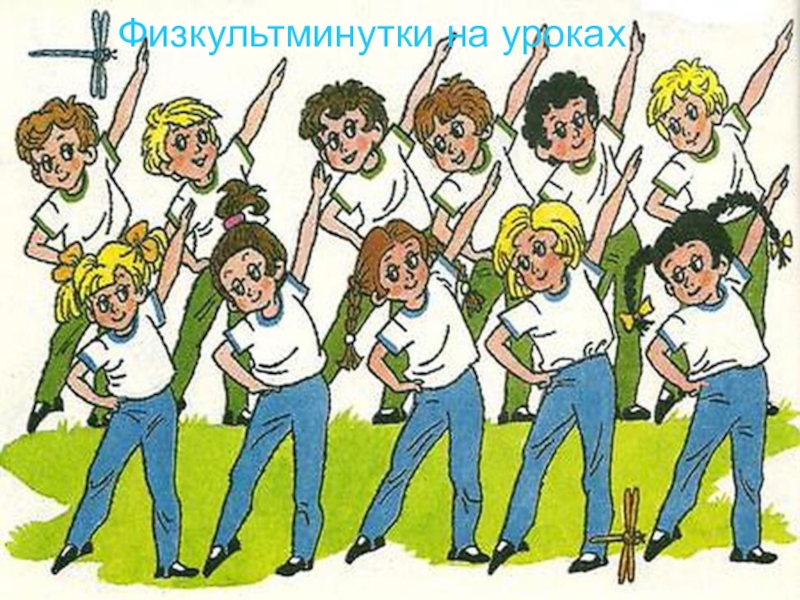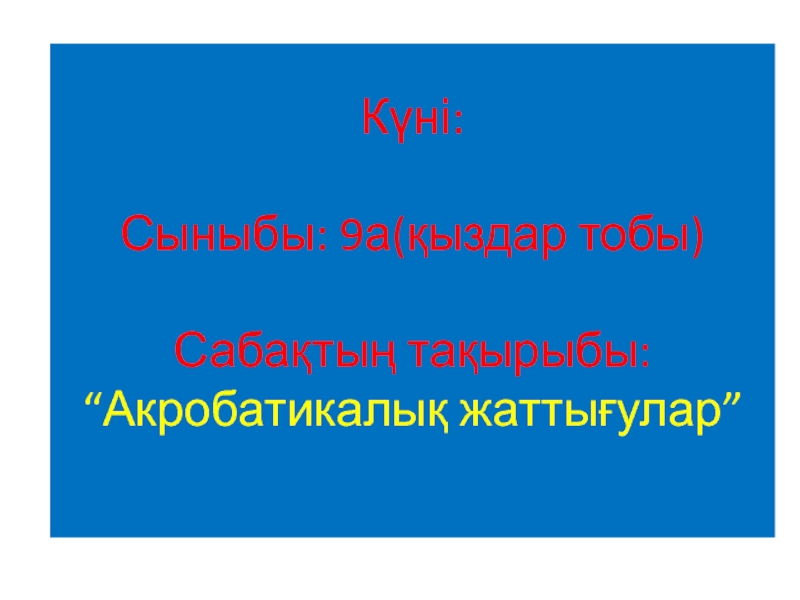The Role of Schools in Promoting Youth Physical Activity
- Главная
- Разное
- Образование
- Спорт
- Естествознание
- Природоведение
- Религиоведение
- Французский язык
- Черчение
- Английский язык
- Астрономия
- Алгебра
- Биология
- География
- Геометрия
- Детские презентации
- Информатика
- История
- Литература
- Математика
- Музыка
- МХК
- Немецкий язык
- ОБЖ
- Обществознание
- Окружающий мир
- Педагогика
- Русский язык
- Технология
- Физика
- Философия
- Химия
- Шаблоны, фоны, картинки для презентаций
- Экология
- Экономика
Презентация, доклад на тему The Role of Schools in Promoting Youth Physical Activity
Содержание
- 1. The Role of Schools in Promoting Youth Physical Activity
- 2. Presentation ObjectivesIdentify the benefits of regular physical
- 3. A Day in the Life of Colin:
- 4. What Are the Benefits of Physical
- 5. How Much Physical Activity Do Youth
- 6. What Does This Really Mean?At least 60 minutes every dayMostly aerobic activitiesAdd variety and fun
- 7. What are Aerobic Activities?Activities that keep your
- 8. Judging the Intensity of Aerobic ActivitiesModerate-intensity ActivityHeart
- 9. Types of Moderate- and Vigorous- Intensity Aerobic Activities
- 10. What are Muscle-Strengthening Activities?Activities that make muscles
- 11. Types of Muscle-Strengthening Activities
- 12. What Are Bone-Strengthening Activities?Activities that produce a
- 13. Types of Bone-strengthening Activities
- 14. How Are the Guidelines for Youth Different
- 15. Meeting the GuidelinesGetting and Staying Active
- 16. How Physically Active Are High School Students?*
- 17. How Much Do 9- to 13- Year-Olds Participate in Physical Activity? Source: MMWR 2003;52(33):785–8.
- 18. Meeting the GuidelinesYouth Who Don’t Meet the
- 19. A Day in the Life of ColinWalks
- 20. Colin’s Weekly Physical Activities
- 21. Colin’s Weekly Activities, cont.
- 22. Maria: A 16-Year-Old AdolescentMaria participates in many
- 23. A Day in the Life of MariaWalks
- 24. Barriers to Meeting the GuidelinesPersonalAttitudeBelief in ability
- 25. YOUTH PHYSICAL ACTIVITY
- 26. Youth Physical ActivityThe Role of Schools
- 27. Why is Physical Activity Important For Schools?Associated
- 28. Physical Education and Academic Achievement1Nationally representative sample:
- 29. Comprehensive School-Based Physical Activity Program1Components include:Quality physical
- 30. Physical Activity vs. Physical Education1Physical activity =
- 31. What is Quality Physical Education? Opportunity to
- 32. Other Characteristics of Quality Physical Education ProgramsEnjoyable
- 33. Recess1. National Association for Sport and Physical
- 34. Physical Activity Break Ideas: Ask students to
- 35. Intramural SportsCan be offered before, during, and
- 36. Interscholastic SportsHelp establish cooperative and competitive skills1Help
- 37. Benefits of Active Commuting to SchoolIncreases physical
- 38. Prevalence of Active Commuting to or from SchoolSource: Am J Prev Med 2007;32(6):509–16.
- 39. Walk and Bicycle to School ProgramsResources:Safe Routes
- 40. Working Together: Joint Use AgreementsShare resources: athletic
- 41. Working Together: Community Involvement In School-Based
- 42. YOUTH PHYSICAL ACTIVITY
- 43. Thank you!Questions? Be Active and Play,
Слайд 1
Your Name
Organization or Group
Date of Presentation
The Physical Activity Guidelines for Children
Слайд 2Presentation Objectives
Identify the benefits of regular physical activity among youth
Describe the
Describe the role of schools, in partnership with families and communities, in promoting physical activity among children and adolescents
Слайд 3A Day in the Life of Colin:
A 7-Year-Old Child
Walks to
Jumps rope and does gymnastics in physical education class
Plays on the playground during recess
Does homework
Watches television
Plays soccer with family
Plays video games
Слайд 4What Are the Benefits of
Physical Activity?
Promotes health and fitness
Builds healthy
Reduces the risk of developing obesity and risk factors for diseases such as type 2 diabetes and heart disease1
Reduces the symptoms of anxiety and depression1
Can positively affect concentration, memory, and classroom behavior2
1. HHS. Physical Activity Guidelines Advisory Committee Report;2008
2. J Pediatr 2005;146(6):732–7.
Слайд 5How Much Physical Activity
Do Youth Need?
Children and adolescents should do
Aerobic Activities: Most of the 60 or more minutes per day should be either moderate- or vigorous-intensity aerobic physical activity. Include vigorous-intensity physical activity at least 3 days per week.
Muscle-strengthening Activities: Include muscle-strengthening physical activity on at least 3 days of the week, as part of the 60 or more minutes.
Bone-strengthening Activities: Include bone-strengthening physical activity on at least 3 days of the week, as part of the 60 or more minutes.
Activities should be age-appropriate, enjoyable, and offer variety.
Слайд 6What Does This Really Mean?
At least 60 minutes every day
Mostly aerobic
Add variety and fun
Слайд 7What are Aerobic Activities?
Activities that keep your body moving enough to
There are two intensities of aerobic activity:
Moderate-intensity
Vigorous-intensity
Слайд 8Judging the Intensity of Aerobic Activities
Moderate-intensity Activity
Heart will beat faster than
On a scale of 0 to 10, moderate-intensity activity is a 5 or 6
Vigorous-intensity Activity
Heart will beat much faster than normal and breathing will be much harder than normal
On a scale of 0 to 10, a vigorous-intensity activity is 7 or 8
Слайд 10What are Muscle-Strengthening Activities?
Activities that make muscles do more work than
Activities that can be part of unstructured play
Climbing trees
Playing tug-of-war
Activities that can be structured
Push-ups, pull-ups
Working with resistance bands
Lifting weights
Слайд 12What Are Bone-Strengthening Activities?
Activities that produce a force on the bones
Activities that are especially important for young people because the greatest gain in bone mass occur during the years just before and during puberty
Слайд 14How Are the Guidelines for Youth Different from the Guidelines for
Take into consideration natural activity patterns of children
All episodes of moderate- or vigorous-intensity activities count toward daily requirement
Unstructured active play can provide all three types of physical activity
Daily physical activity required
Specify need for bone-strengthening activities and vigorous-intensity activities each week
Слайд 16How Physically Active Are High School Students?
* Were physically active doing
Source: National Youth Risk Behavior Survey, 2007.
Слайд 17 How Much Do 9- to 13- Year-Olds Participate in Physical Activity?
Source: MMWR 2003;52(33):785–8.
Слайд 18Meeting the Guidelines
Youth Who Don’t Meet the Guidelines
Slowly increase activity in
Participate in enjoyable activities
Youth Who Meet the Guidelines
Continue being active on a daily basis
Work toward becoming more active
Youth Who Exceed the Guidelines
Maintain activity level
Vary the kinds of activities to reduce the risk of injury
Слайд 19A Day in the Life of Colin
Walks to and from school
Jumps rope and does gymnastics in physical education class (10 minutes each).
Plays on the playground during recess (10 minutes)
Does homework (20 minutes)
Watches television (30 minutes)
Plays soccer with family (20 minutes)
Plays video games (30 minutes)
Total physical activity time = 60 minutes
Vigorous-intensity aerobic activity: jumping rope
Bone-strengthening activities: jumping rope, gymnastics
Muscle-strengthening activities: gymnastics
Слайд 22Maria: A 16-Year-Old Adolescent
Maria participates in many types of physical activities
She plays tennis and does sit-ups and push-ups during physical education class
She likes to play basketball at the YMCA, do yoga, and go dancing with her friends
She likes to walk and hike with her dog
Слайд 23A Day in the Life of Maria
Walks dog (10 minutes)
Plays tennis
Does sit-ups and push-ups (5 minutes)
Plays with children at the park while babysitting (15 minutes)
Total physical activity time = 60 minutes
Vigorous-intensity aerobic activity: tennis
Bone-strengthening activity: tennis
Muscle-strengthening activity: sit-ups and push-ups
Слайд 24Barriers to Meeting the Guidelines
Personal
Attitude
Belief in ability to be physically active
Social
Influence
Parental support
Environmental
Safe locations to be active
Access to equipment
Financial costs of physical activities
Time
Слайд 27Why is Physical Activity Important For Schools?
Associated with lower levels of
Can positively affect concentration, memory, and classroom behavior among adolescents2
Can improve standardized test scores3
1. HHS. Physical Activity Guidelines Advisory Committee Report;2008.
2. J Pediatr 2005;146(6)719–20.
3. Res Q Exerc Sport 1999;70(2):127–34.
Слайд 28Physical Education and Academic Achievement1
Nationally representative sample: 5,316 students starting kindergarten
Physical education (PE) measure: Low (0–35 mins/week), Medium (36–69), High (70–300)
Academic achievement measure: Mathematics and reading tests designed by experts
Results: A small but significant benefit on both math and reading tests were observed for girls in the high PE category compared with those in the low PE category; findings not seen in boys
1. Am J Pub Health 2008;98(4):72–7.
Слайд 29Comprehensive School-Based Physical Activity Program1
Components include:
Quality physical education
Daily recess period
Activity breaks
Intramural sports
Interscholastic sports
Walk- and bike-to-school programs
Staff wellness and involvement
Family and community participation
1. National Association for Sport and Physical Education. Comprehensive School Physical Activity Programs Package; 2008.
Слайд 30Physical Activity vs. Physical Education1
Physical activity = behavior
Physical education = curricular
Provides students with the skills needed to participate in a lifetime of physical activity
1. National Association for Sport and Physical Education. Understanding The Difference: Is It Physical Education or Physical Activity?;2005.
Слайд 31What is Quality Physical Education?
Opportunity to learn
Adequate time, equipment, and
Highly qualified, certified, or licensed teachers
Meaningful content
Written standards-based curriculum
Sequential, developmentally appropriate learning activities for grades K–12
Appropriate instruction
Full inclusion of all students
Well-designed lessons that facilitate learning
Sufficient practice opportunities for class activities
Student assessment
Слайд 32Other Characteristics of Quality Physical Education Programs
Enjoyable experience for all students
Meet
Keep students active for most of class time
More than 50% of class time spent in moderate- to vigorous-intensity activity
1. National Association for Sports and Physical Education. Moving into the Future: National Standards for Physical Education, 2nd ed;2004.
Policy Recommendation: Schools should require daily PE for students in kindergarten through grade 121
Elementary school = 150 minutes per week
Secondary school = 225 minutes per week
Слайд 33Recess
1. National Association for Sport and Physical Education. Recess in Elementary
Opportunity to participate in free-time physical activity and practice skills learned in physical education classes
Enhances cooperation and negotiation skills
Improves attentiveness, concentration, and time-on-task in the classroom
Policy Recommendation: Schools should provide at least 20 minutes of recess per day, in addition to physical education classes1
Слайд 34Physical Activity Break Ideas: Ask students to identify and act out
Physical Activity Breaks
Independent of physical education and recess
Can enhance positive classroom behavior of students
Incorporates activity in the classroom as part of planned lessons
Слайд 35Intramural Sports
Can be offered before, during, and after school
Provide students with
Offer every student an equal opportunity to participate regardless of ability level
Incorporate lifetime physical activities such as walking, running, hiking, swimming, tennis, dancing, and bicycling
Слайд 36Interscholastic Sports
Help establish cooperative and competitive skills1
Help students learn sport-specific and
May be related to higher levels of overall physical activity2
Associated with improved mental health and reduction in some risky health behaviors3–4
1. National Association for Sports and Physical Education. Eight Domains of Coaching Competencies;2006.
2. Pediatr Exerc Sci 1998;10:378–86.
3. Arch Pediatr Adolesc Med 2000;154:904–11.
4. The President's Council on Physical Fitness and Sports. Research Digest 1997;2:1–12.
Слайд 37Benefits of Active Commuting to School
Increases physical activity levels1–3
Reduces the number
Promotes partnerships among students, parents and community organizations and members
1. Am J Prev Med 2005;29(3):179–84.
2. BMJ 2005;331(7524)1061–2.
3. Med Sci Sports Exerc 2005;37(12):2062–9.
Слайд 39Walk and Bicycle to School Programs
Resources:
Safe Routes to Schools
Walking School Bus
KidsWalk
Activity Recommendation: Schools should participate in International Walk to School Week and support ongoing walk and bike to school programs
Слайд 40Working Together:
Joint Use Agreements
Share resources: athletic fields, playgrounds and fitness facilities
Open school facilities to provide physical activity programs to students, families, school staff, and community members.
Seek funding from local businesses, community groups and health organizations for physical activity programs and events
Слайд 41Working Together:
Community Involvement In School-Based Physical Activity
Support school-based
physical activity
Join the
Donate equipment, money or encourage staff to volunteer time
Support Safe Routes to School programs
Offer after-school physical activity programs
















































